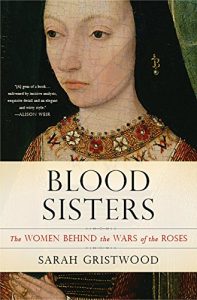From the Archives: Blood Sisters
I have started and abandoned three blog post topics this morning. Two of them were based on pieces of information that turned out to be not quite correct when I looked at them more closely. And the third was a little known moment within a well-known story: the moment was too small to support a post by itself and the well-known story was too well known to re-tell here. *Sigh*
Luckily I had reason to rummage on my bookshelves recently in response to a request for books about historical women prior to 1700. I now have a list of books that I’ve reviewed here on the Margins that I would be happy to recommend to anyone. I will fall back on them when and as needed in the coming weeks. (Thanks, Linnie.)
First up, Blood Sisters by Sarah Gristwood, which I reviewed in 2013. (The news referred to in the first sentence is no longer new, though it was the subject of a film, The Lost King, which was released in March, 2023. Apparently Richard III is able to generate endless controversy.)
With the discovery of Richard III’s bones under a Leister parking lot, the Wars of the Roses are in the news again. Historians and hobbyists alike are arguing the relative claims of Lancaster and York across the media. In Blood Sisters: The Women Behind the Wars of the Roses, Sarah Gristwood tells the familiar story of the so-called “Cousins’ War” from a new perspective.
As Gristwood points out, most histories of the period echo the “patriarchial assumptions” of the time and focus on its male protagonists. In Blood Sisters, kings and kingmakers take a back seat to their mothers, wives, sisters and daughters. Some, like heiress Anne Neville, were passed from one royal family to another like pieces of property. Others were actively involved in the politics of the time, using husbands and sons as their path to power. Whether pawns or players, all were caught up in the web of changing alliances, family loyalties and political machinations that defined the war. Gristwood pieces together their stories from their household accounts, their occasional letters, and their appearances in the accounts of others.
At its heart, Blood Sisters is about relationships. Gristwood describes the events surrounding the Wars of the Roses and the resultant rise of the Tudor dynasty as a family saga whose protagonists were tied together in numerous ways. By focusing on the lives of the Plantagenet women, she illustrates the complexities of those ties–creating a larger picture of the Wars of the Roses in the process.





